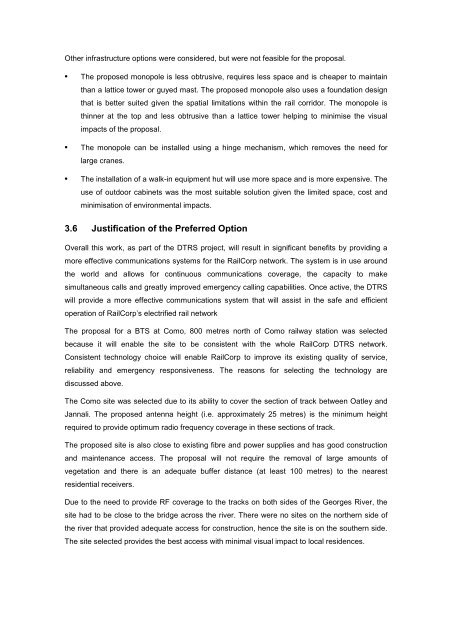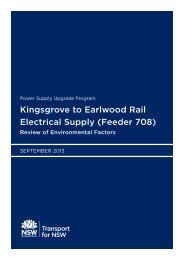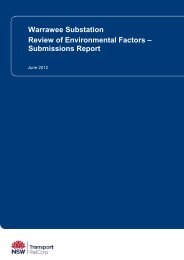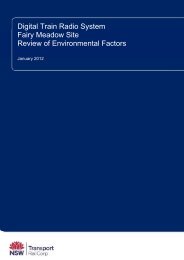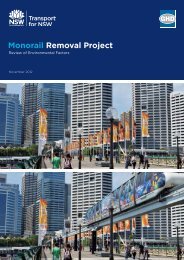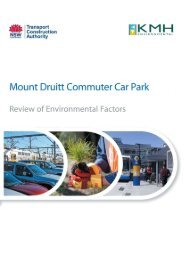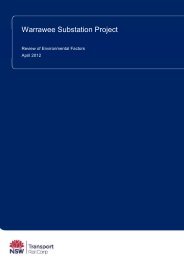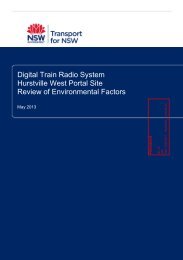Digital Train Radio System Como Site Review of Environmental ...
Digital Train Radio System Como Site Review of Environmental ...
Digital Train Radio System Como Site Review of Environmental ...
You also want an ePaper? Increase the reach of your titles
YUMPU automatically turns print PDFs into web optimized ePapers that Google loves.
Other infrastructure options were considered, but were not feasible for the proposal.<br />
• The proposed monopole is less obtrusive, requires less space and is cheaper to maintain<br />
than a lattice tower or guyed mast. The proposed monopole also uses a foundation design<br />
that is better suited given the spatial limitations within the rail corridor. The monopole is<br />
thinner at the top and less obtrusive than a lattice tower helping to minimise the visual<br />
impacts <strong>of</strong> the proposal.<br />
• The monopole can be installed using a hinge mechanism, which removes the need for<br />
large cranes.<br />
• The installation <strong>of</strong> a walk-in equipment hut will use more space and is more expensive. The<br />
use <strong>of</strong> outdoor cabinets was the most suitable solution given the limited space, cost and<br />
minimisation <strong>of</strong> environmental impacts.<br />
3.6 Justification <strong>of</strong> the Preferred Option<br />
Overall this work, as part <strong>of</strong> the DTRS project, will result in significant benefits by providing a<br />
more effective communications systems for the RailCorp network. The system is in use around<br />
the world and allows for continuous communications coverage, the capacity to make<br />
simultaneous calls and greatly improved emergency calling capabilities. Once active, the DTRS<br />
will provide a more effective communications system that will assist in the safe and efficient<br />
operation <strong>of</strong> RailCorp’s electrified rail network<br />
The proposal for a BTS at <strong>Como</strong>, 800 metres north <strong>of</strong> <strong>Como</strong> railway station was selected<br />
because it will enable the site to be consistent with the whole RailCorp DTRS network.<br />
Consistent technology choice will enable RailCorp to improve its existing quality <strong>of</strong> service,<br />
reliability and emergency responsiveness. The reasons for selecting the technology are<br />
discussed above.<br />
The <strong>Como</strong> site was selected due to its ability to cover the section <strong>of</strong> track between Oatley and<br />
Jannali. The proposed antenna height (i.e. approximately 25 metres) is the minimum height<br />
required to provide optimum radio frequency coverage in these sections <strong>of</strong> track.<br />
The proposed site is also close to existing fibre and power supplies and has good construction<br />
and maintenance access. The proposal will not require the removal <strong>of</strong> large amounts <strong>of</strong><br />
vegetation and there is an adequate buffer distance (at least 100 metres) to the nearest<br />
residential receivers.<br />
Due to the need to provide RF coverage to the tracks on both sides <strong>of</strong> the Georges River, the<br />
site had to be close to the bridge across the river. There were no sites on the northern side <strong>of</strong><br />
the river that provided adequate access for construction, hence the site is on the southern side.<br />
The site selected provides the best access with minimal visual impact to local residences.


